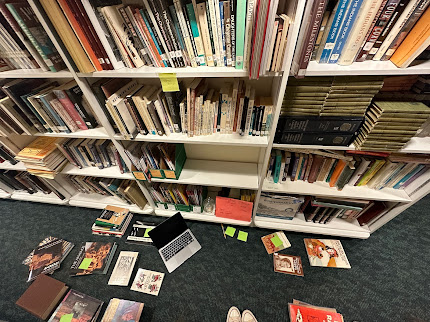Week 1 Reflection
The first week of my senior project helped me learn a lot about the Lovejoy Library. I never could have imagined what 40 hours and 30 minutes working in a library looked like before this. I began my week in the archive section simply sorting through books every day. It was a learning process because I didn’t know which categories books should go into or what to look for. I was worried about missing some offensive terms or having problematic books go back on the shelves. Throughout the week I learned how to better categorize and sort the books that Proctor has in the Lovejoy Library Native American collection. As the week went on I felt more confident and speedy with the sorting process. The books that I did end up pulling were very insensitive and racist and it was hard to think that they were on the Proctor shelves not so long ago. I am glad that I was able to find them and remove them from the public collection. I wouldn't want there to be harmful information in a collection that is meant to spread knowledge and understanding. In my first week, I also learned that rolling carts and tons of shelf space are a must for organizing mass amounts of books. Through trial and error, I figured out the best way to stack books for carrying by hand. While putting books away I learned the dewy decimal system better and the structure of the Lovejoy Library.
Once I was done with all the sorting, I had to move on to organizing the books on the shelves. Something I initially didn't take into consideration was that the shelves need to be aesthetically pleasing. Having a massive row of books with no outward-facing covers can look intimidating and not very inviting. Once I learned that this was a must the collection started to look a lot better. I also had to learn that the books I find super interesting might not appeal to every student. Given my previous knowledge, I did not find the general history/information books very interesting but I understand that many students might need an easier starting place than a book on Wilma Mankiller. I learned how to put on my critical thinking glasses and contemplate whether or not a 9th or 10th grader would willingly pick up this book. Once I learned how to be more critical about the books most students wouldn’t reach for, I was able to break up the front and back displays better. I attached labels to the shelves and put the oversized photography books on the top shelves. Not only do they let someone know what the collection is about at first glance but they also are easy to pick up and skim through. Heidi talked to me about the idea of “coffee table books” which are easy to flip through during some downtime.
Next week I am looking forward to talking to educators here about their current and future curriculums. I have gotten a lot of encouragement from the teachers that see what I have been working on and I hope that energy translates into their classes as well. I find that if my teacher is passionate about a topic it makes me more likely to learn more about it and I hope that this also happens with the Native American collection. I am excited to recommend books for teachers to use in the classroom setting and also for personal reads. It always brings me joy when people are willing to learn more and set outside of their comfort zone. As people become more educated I also hope more people will want to go on the Rosebud Summer Service Trip. Proctor Academy’s Native American connections and the service trip are both valuable and unique to this New England boarding school. Many other schools in this area have little to no information on Native Americans in their libraries, let alone a whole designated collection. The Native American connection program at Proctor is one of the main reasons that I chose to come here because it made me feel welcomed. I hope that this pattern will continue to ripple outwards and attract more Native students to Andover in the coming years.



Comments
Post a Comment